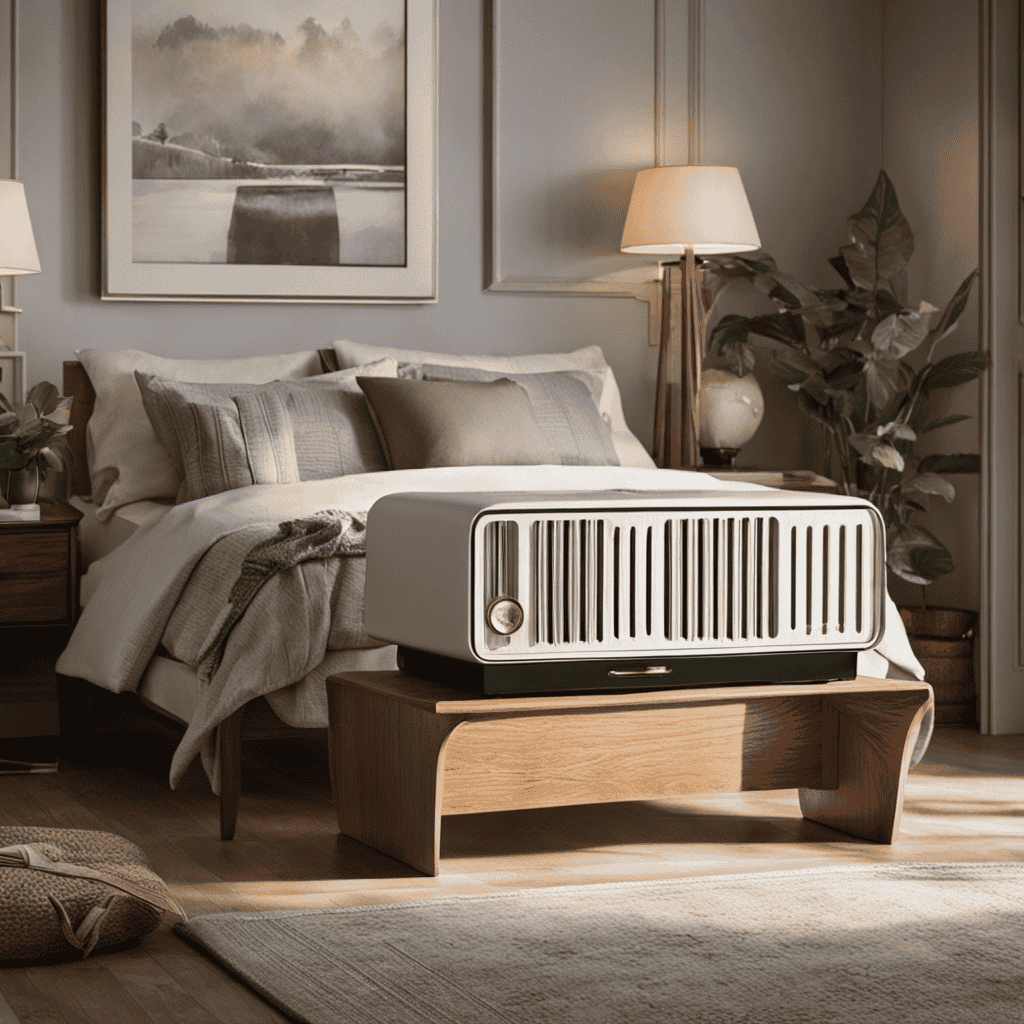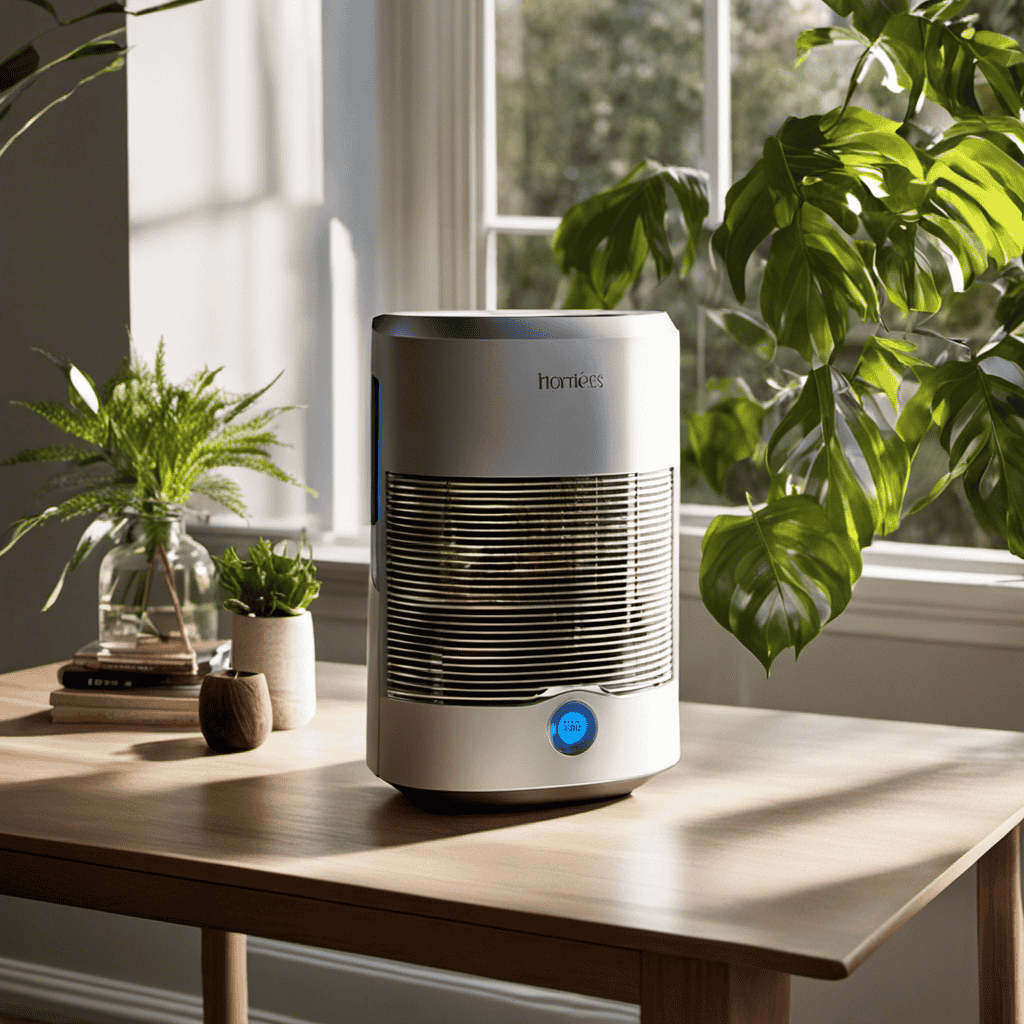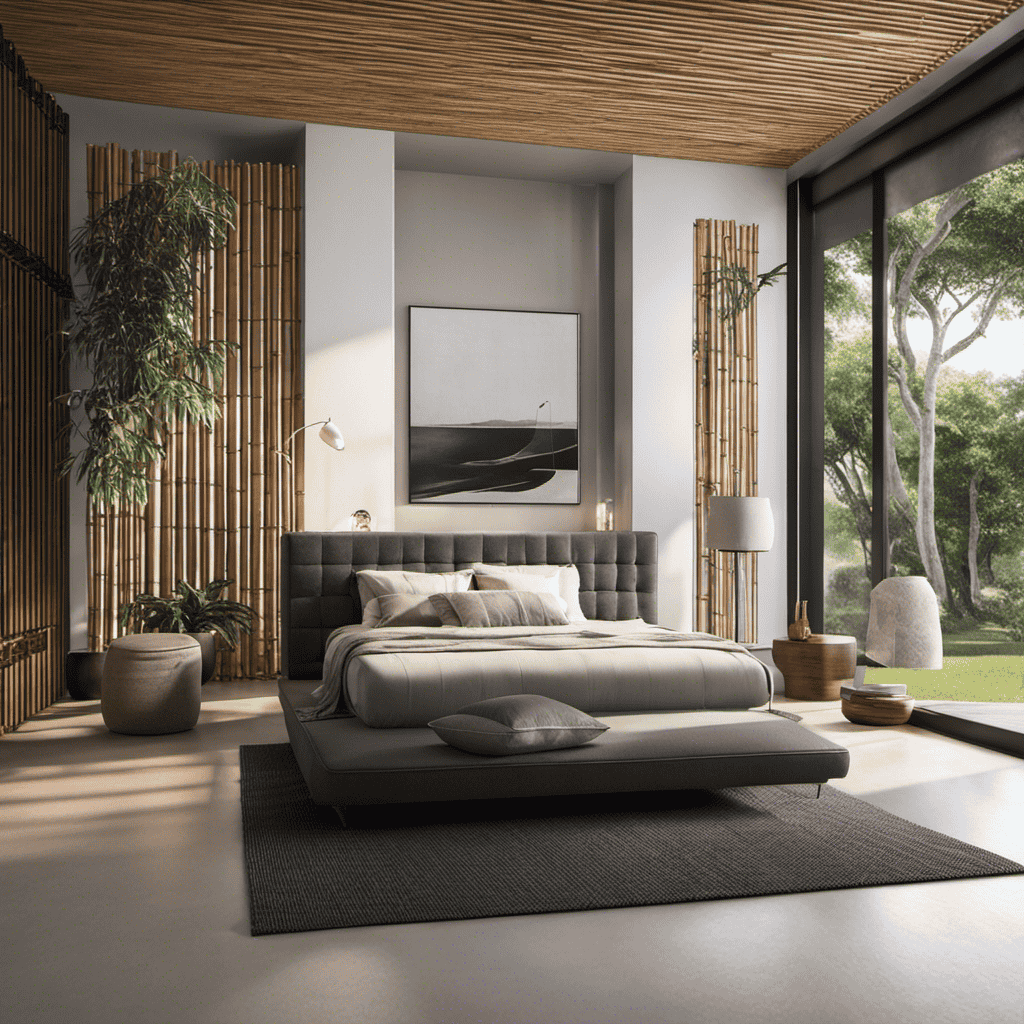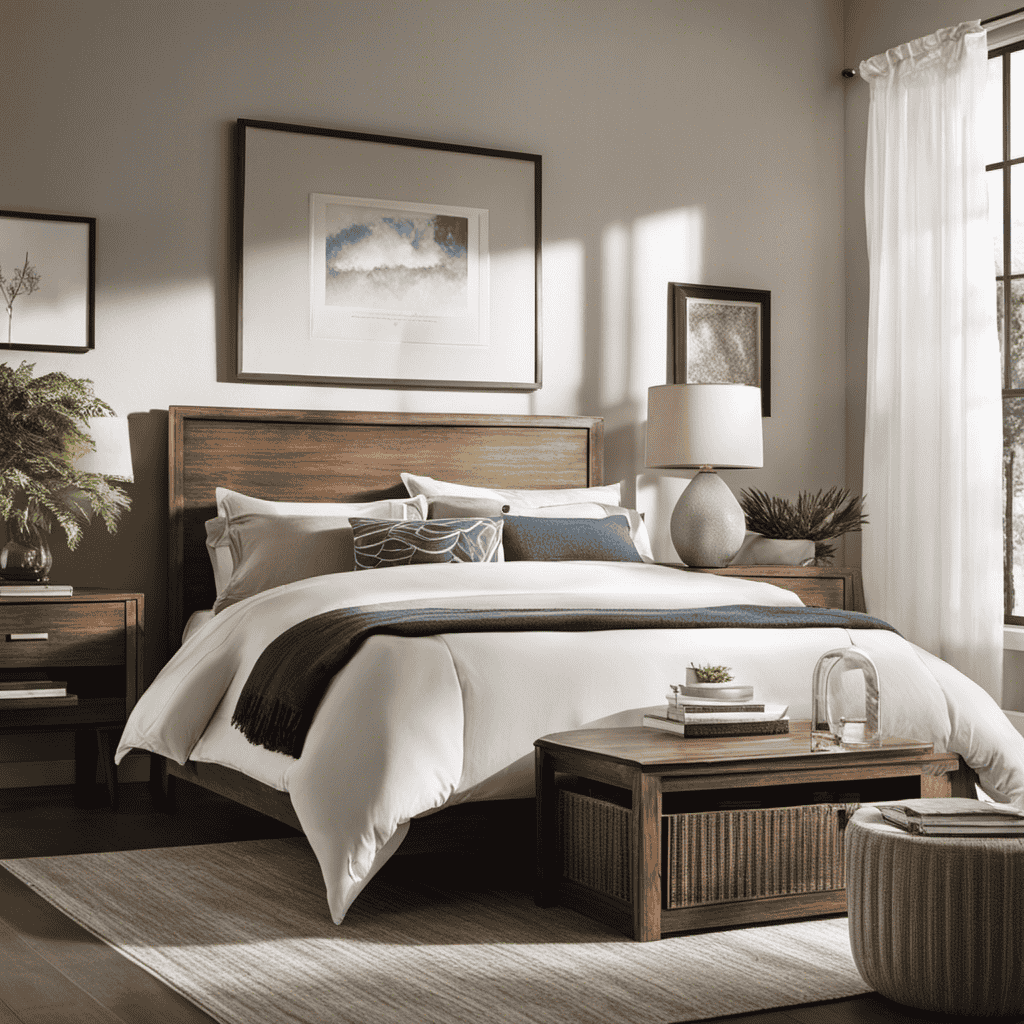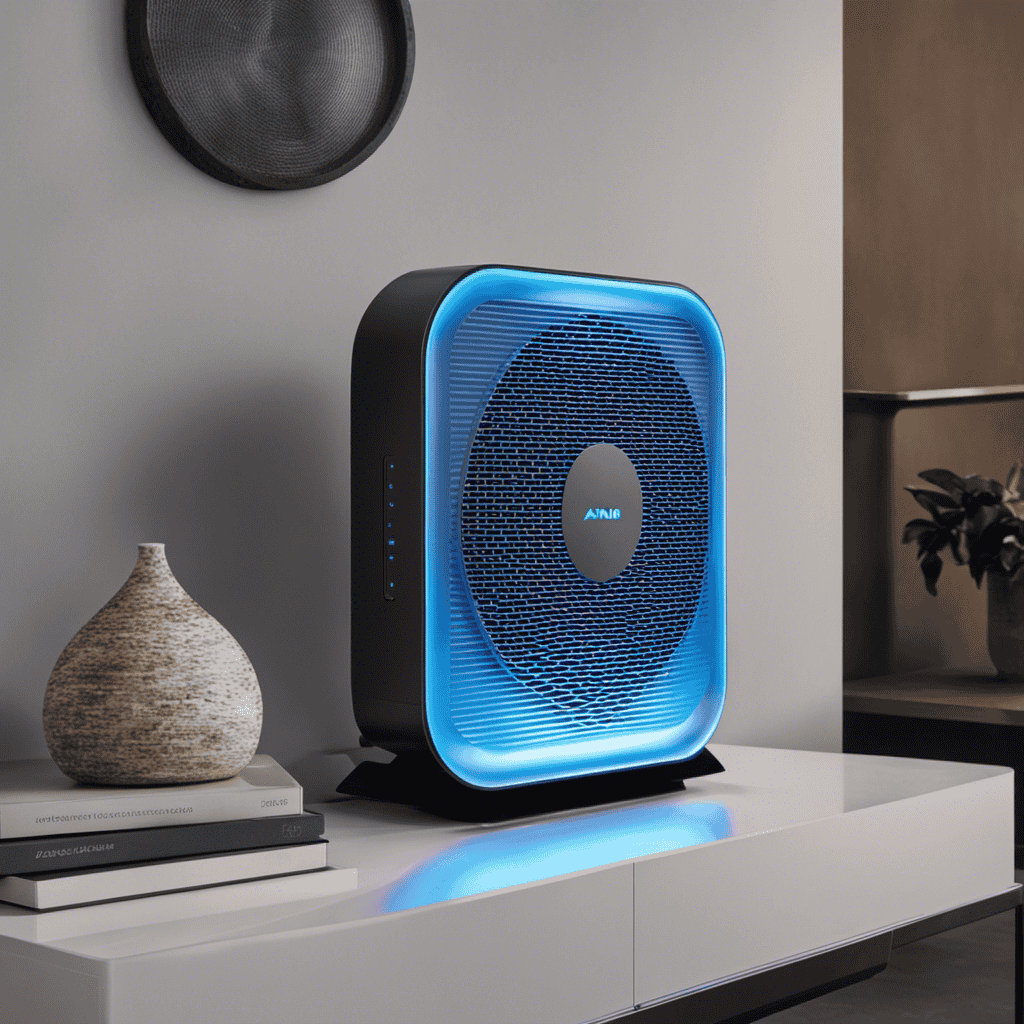As someone who cares about their health and well-being, were you aware that indoor air quality can be up to five times worse than outdoor air quality? I recognize the significance of breathing clean air.
That’s why I want to shed light on the benefits of using an air purifier. In this article, I will explore the ways air purifiers improve indoor air quality, the dangers of common indoor air pollutants, and how to choose the right air purifier for your needs.
Let’s dive into the world of air purification and discover why it’s a necessity in today’s polluted environment.
Key Takeaways
- Air purifiers remove harmful particles and pollutants from the air, improving air quality.
- They effectively reduce allergens such as pollen, dust mites, and pet dander, reducing respiratory symptoms.
- Air purifiers help eliminate volatile organic compounds (VOCs) and other potentially hazardous chemicals.
- By creating a healthier indoor environment, air purifiers reduce the risk of respiratory conditions and chronic diseases related to indoor air pollutants.
Health Benefits of Using an Air Purifier
Using an air purifier can help to improve your overall health and well-being. Air purifiers are designed to remove harmful particles and pollutants from the air, which can have significant benefits for those with allergies and respiratory symptoms.
Studies have shown that air purifiers can effectively reduce allergens such as pollen, dust mites, and pet dander in indoor environments. This can lead to a decrease in allergic reactions and symptoms, such as sneezing, coughing, and itchy eyes.
Additionally, air purifiers can help to reduce respiratory symptoms by removing irritants like smoke, volatile organic compounds (VOCs), and mold spores from the air. By improving the quality of the air we breathe, air purifiers provide a valuable tool for maintaining good health and preventing respiratory issues.
How Air Purifiers Improve Indoor Air Quality
Air purifiers offer numerous benefits, including the ability to create a healthier indoor environment. These devices work by removing harmful pollutants and allergens from the air, reducing the risk of respiratory issues and improving overall air quality.
Studies have shown that air purifiers can effectively reduce the presence of airborne particles, such as dust, pollen, and pet dander, leading to a cleaner and safer living space.
Benefits of Air Purifiers
Did you know that having an air purifier can greatly improve the quality of the air you breathe?
Air purifiers have numerous health benefits and play a crucial role in improving air quality indoors. They effectively remove harmful pollutants and allergens from the air, such as dust, pollen, pet dander, and mold spores. This can significantly reduce the risk of respiratory conditions like asthma and allergies.
Studies have also shown that air purifiers can help eliminate volatile organic compounds (VOCs) and other potentially hazardous chemicals present in indoor environments. By removing these pollutants, air purifiers create a healthier indoor environment, promoting better overall well-being.
With cleaner air, you can breathe easier and enjoy the benefits of a fresher and safer living space.
Healthier Indoor Environment
Having an air purifier can greatly improve the quality of the air I breathe indoors, creating a healthier environment for me and my family.
Indoor air pollution is a significant concern, especially since we spend so much time indoors.
One major source of indoor air pollutants is cleaning products. Many of these products contain harmful chemicals that can negatively impact our health.
Air purifiers work by removing these pollutants from the air, reducing our exposure and potential health risks.
Studies have shown that air purifiers can effectively remove airborne particles and chemicals, including those from cleaning products.
Common Indoor Air Pollutants and Their Dangers
I want to discuss the health risks associated with indoor air pollutants and the benefits of using air purifiers to mitigate these risks.
Indoor air pollutants, such as carbon monoxide, volatile organic compounds (VOCs), and particulate matter, can have detrimental effects on our health. These pollutants can lead to respiratory problems, allergies, and even cardiovascular issues.
However, by using air purifiers, we can effectively remove these pollutants from our indoor environments. Air purifiers work by filtering out harmful particles and gases, improving the overall air quality in our homes and workplaces.
By improving indoor air quality through the use of air purifiers, we can reduce the risk of developing health issues related to indoor air pollutants. This can lead to improved respiratory function, fewer allergies, and a decreased risk of cardiovascular problems.
Health Risks of Pollutants
You should be aware of the health risks associated with pollutants and why an air purifier can help mitigate them.
Air pollution effects can have serious consequences on our health, including respiratory issues, cardiovascular problems, and even cancer. According to studies, long-term exposure to pollutants can lead to chronic diseases and reduce life expectancy.
Air purifiers are highly effective in removing harmful pollutants from the air we breathe. They use filters and technologies such as HEPA filters, activated carbon filters, and UV-C light to capture and destroy pollutants like dust, pollen, pet dander, mold spores, and volatile organic compounds (VOCs).
These devices can significantly improve indoor air quality, reducing the risk of health problems associated with air pollution.
Investing in an air purifier is a proactive step towards safeguarding your health and well-being.
Benefits of Air Purifiers
Improving indoor air quality is key to reducing the risk of health problems associated with air pollution. One effective solution is using air purifiers.
These devices are designed to remove pollutants and impurities from the air, thus improving the overall air quality in a room. By doing so, they can have a significant impact on improving allergies and reducing asthma symptoms.
Scientific studies have shown that air purifiers can effectively remove common allergens such as dust mites, pet dander, and pollen, leading to a reduction in allergy symptoms. Additionally, air purifiers can also filter out fine particles and volatile organic compounds (VOCs) that can trigger asthma attacks.
With their ability to remove these harmful substances from the air, air purifiers play a vital role in creating a healthier indoor environment for individuals with allergies and asthma.
Choosing the Right Air Purifier for Your Needs
When choosing the right air purifier for your needs, it’s important to consider the size of the room. Here are four factors to consider:
-
Air purifier brands: Research reputable brands known for their effective air purification systems. Look for brands that offer a range of models to suit different room sizes and filtration needs.
-
Room size: Measure the square footage of the room where you plan to use the air purifier. Different models are designed to effectively clean the air in specific room sizes, so choose one that matches your room dimensions.
-
Filtration technology: Look for air purifiers with high-efficiency particulate air (HEPA) filters. These filters can remove over 99% of airborne particles, including allergens, dust, and pet dander.
-
Maintenance requirements: Consider the maintenance needs of the air purifier. Look for models that have easy-to-replace filters and clear instructions on when and how to clean or replace them.
Choosing the right air purifier can play a vital role in improving indoor air quality and alleviating allergy symptoms.
The Role of Air Purifiers in Allergy Relief
To alleviate allergy symptoms, consider the role air purifiers play in improving indoor air quality.
Air purifiers can be an effective tool in managing asthma symptoms and reducing exposure to allergens such as pet dander.
According to scientific studies, air purifiers can help remove airborne particles that trigger asthma attacks, providing relief to asthma sufferers.
These devices work by using filters to capture and trap allergens like pet dander, pollen, and dust mites, preventing them from circulating in the air.
Research has shown that air purifiers can significantly reduce the levels of pet dander in homes, making it easier for individuals with pet allergies to breathe and reducing the risk of allergic reactions.
Therefore, incorporating an air purifier into your allergy management plan can greatly improve your indoor air quality and provide relief from allergy symptoms.
Enhancing Sleep Quality With an Air Purifier
As someone who values a good night’s sleep, I have always been interested in finding ways to improve my sleep quality.
One aspect that often gets overlooked is the impact of indoor air quality on our sleep. Research has shown that using an air purifier in the bedroom can have several benefits for sleep, including reducing allergens and pollutants, eliminating sleep irritants, and creating a cleaner and healthier sleep environment.
Purifier Benefits for Sleep
Using an air purifier can help you sleep better at night by removing allergens and improving the overall air quality in your bedroom. Here are four ways an air purifier can positively impact your sleep quality and reduce allergies:
-
Removes airborne allergens: Air purifiers can capture and eliminate common allergens like dust mites, pollen, pet dander, and mold spores, which can trigger allergies and disrupt sleep.
-
Filters out harmful particles: Air purifiers with HEPA filters can trap fine particles, such as smoke, bacteria, and viruses, ensuring you breathe cleaner air while you sleep.
-
Reduces indoor pollutants: Indoor air pollution can be up to five times worse than outdoor air. An air purifier can help remove pollutants like volatile organic compounds (VOCs), chemicals, and odors, creating a healthier sleep environment.
-
Improves respiratory health: By reducing allergens and pollutants, an air purifier can alleviate symptoms of asthma and respiratory conditions, promoting better sleep and overall well-being.
Eliminating Sleep Irritants
Eliminating sleep irritants can greatly improve the quality of your sleep and contribute to overall well-being. One of the most common sleep irritants is allergies. Allergies can cause discomfort, congestion, and difficulty breathing, which can disrupt sleep patterns.
By improving allergies, you can reduce nighttime congestion and promote better sleep. Scientific studies have shown that air purifiers can effectively reduce allergens in the air, such as dust mites, pet dander, and pollen. These purifiers use filters to capture and trap these allergens, preventing them from circulating in the air and causing irritation.
This can lead to a significant reduction in nighttime congestion, allowing for clearer breathing and a more restful sleep. In fact, a study published in the Journal of Allergy and Clinical Immunology found that using an air purifier reduced allergic rhinitis symptoms and improved sleep quality.
Air Purifiers Vs. Ventilation Systems: Which Is Better
Air purifiers and ventilation systems have different strengths, and it’s important to understand which one is better for your specific needs. Here are four factors to consider when comparing air purifiers and ventilation systems:
-
Effectiveness: Air purifiers are specifically designed to remove pollutants from the air, whereas ventilation systems primarily circulate the air. This makes air purifiers more effective at removing allergens, dust, and other harmful particles.
-
Drawbacks of ventilation systems: While ventilation systems help to improve air circulation, they may not effectively filter out pollutants. They can also bring in outdoor pollutants, such as pollen and smog, which can worsen indoor air quality.
-
Targeted purification: Air purifiers can be strategically placed in specific rooms to target areas with higher pollutant concentrations. Ventilation systems, on the other hand, distribute air evenly throughout the entire space.
-
Maintenance and cost: Air purifiers generally require regular filter replacement, while ventilation systems may need periodic cleaning and maintenance. Additionally, air purifiers are available in a wide range of prices, allowing for greater flexibility in budgeting.
Understanding these differences will help you make an informed decision about which option is best for improving your indoor air quality. Now, let’s explore the impact of air pollution on your respiratory system.
The Impact of Air Pollution on Your Respiratory System
Understanding the impact of air pollution on your respiratory system is crucial for maintaining good health.
Air pollution, consisting of harmful particles and gases, can have detrimental effects on your lung function and overall well-being.
Studies have shown that long-term exposure to air pollution can lead to the development and worsening of respiratory conditions such as asthma and chronic obstructive pulmonary disease (COPD).
Additionally, recent research has suggested a link between air pollution and cognitive function, with higher levels of pollution associated with decreased cognitive performance.
To combat these negative effects, air purifiers play an important role in reducing asthma symptoms and improving indoor air quality.
Eliminating Odors and Volatile Organic Compounds (Vocs) With an Air Purifier
After learning about the impact of air pollution on our respiratory system, it’s important to understand how an air purifier can help eliminate odors and volatile organic compounds (VOCs) in our indoor environment.
As someone who suffers from allergies, I have experienced firsthand the discomfort and symptoms that can arise from exposure to pet dander and other allergens.
Here are four ways an air purifier can help in reducing indoor allergy symptoms:
-
Capturing Pet Dander: Air purifiers equipped with HEPA filters can effectively trap pet dander particles, preventing them from circulating in the air and causing allergic reactions.
-
Removing Allergens: Air purifiers can remove common allergens like pollen, dust mites, and mold spores, providing relief to allergy sufferers.
-
Neutralizing Odors: Some air purifiers use activated carbon filters to absorb and eliminate unpleasant odors, including pet odors and cooking smells.
-
Filtering VOCs: Air purifiers with activated carbon or specialized filters can reduce the presence of volatile organic compounds (VOCs) emitted by household products, such as cleaning agents and paints, which can trigger allergy symptoms.
Investing in an air purifier can provide a cleaner and healthier indoor environment, making a significant difference in reducing allergies caused by pet dander and other indoor allergens.
Long-term Cost Savings of Using an Air Purifier
Using an air purifier can save you money in the long run by reducing the need for medication and doctor visits due to allergies.
Allergies can be a costly condition to manage, with expenses for prescription medications, over-the-counter remedies, and doctor visits quickly adding up.
However, research has shown that air purifiers can effectively remove allergens such as dust mites, pollen, and pet dander from the air, reducing the triggers that cause allergic reactions.
By eliminating these triggers, individuals with allergies may experience fewer symptoms and require less medication.
Additionally, air purifiers can also help prevent respiratory infections by removing airborne pathogens. This not only saves money on medical expenses but also improves overall health and well-being.
When choosing an air purifier, it is important to consider its cost effectiveness and energy efficiency to ensure long-term savings.
Frequently Asked Questions
Can an Air Purifier Help With Reducing Pet Dander and Allergens in the Air?
Yes, an air purifier can help reduce pet dander and allergens in the air. It filters out particles like pollen and dust mites, improving air quality and reducing allergy symptoms.
What Size of an Air Purifier Should I Choose for My Bedroom?
Choosing the right size air purifier for your bedroom depends on the square footage of the room. A larger room may require a higher CADR rating to effectively filter allergens and improve air quality.
Are There Any Specific Air Purifiers That Are More Effective for People With Asthma?
There are air purifiers that are more effective for people with asthma. They can help reduce allergens in the air, providing relief and improving air quality for those with respiratory conditions.
Can an Air Purifier Eliminate Cigarette Smoke and Its Odor From the Air?
Yes, an air purifier can eliminate cigarette smoke and its odor from the air. I had one in my home and it significantly improved the air quality, reducing the smell and making it much fresher.
How Often Should I Replace the Filters in My Air Purifier?
To maintain optimal performance, it is important to regularly clean and replace the filters in your air purifier. This ensures that it effectively removes pollutants from the air, promoting a healthier living environment.
Conclusion
In conclusion, an air purifier is a valuable investment for improving indoor air quality and safeguarding your health. By effectively removing common indoor air pollutants such as dust, pollen, and pet dander, air purifiers help reduce the risk of respiratory illnesses and allergies.
They also play a crucial role in eliminating odors and harmful volatile organic compounds (VOCs). With long-term cost savings and the ability to provide allergy relief, air purifiers are like a shield, protecting you and your loved ones from the invisible enemies in the air.
Don’t wait, take control of your indoor air quality today.
